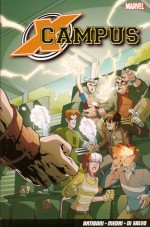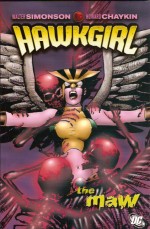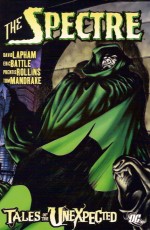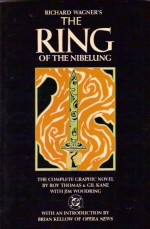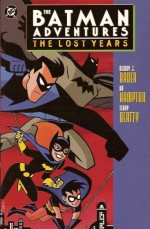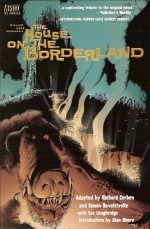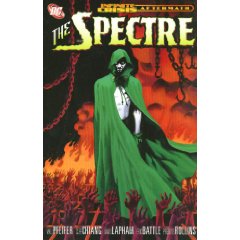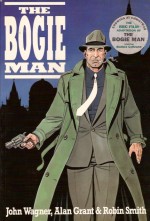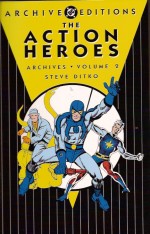
By Steve Ditko and various (DC Comics)
ISBN: 978-1-4012-1346-6
Steve Ditko is possibly American comics’ most unique stylist. Love him or hate him, you can’t mistake his work for anyone else’s. His career began in the early 1950’s and, depending on whether you’re a superhero fan or prefer the deeper and more visually free and experimental work, peaked in either the mid-1960’s or 1970’s.
Leaving the Avenging World, Mr. A and his other philosophically derived creations for another time, the super-hero crowd should heartily celebrate this second deluxe collection of costumed do-gooders created by the master of mood. Although I’m a huge fan of his line-work – which is best served by black and white printing – the crisp, sharp colour of these Archive editions is still far superior to the appalling reproduction on bog-paper that originally introduced Charlton’s heroes to the wide-eyed kids of hippie-happy America, circa 1966.
This second volume completes Ditko’s costumed hero contributions with the remainder of the Captain Atom tales (see Action Heroes Archives volume 1, ISBN 1-4012-0302-7), and the introduction of a new Blue Beetle and the uniquely iconic Question.
Captain Atom #83 (November 1966) starts the ball rolling here with a huge blast of reconstructive character surgery. Although ‘Finally Falls the Mighty!’ was inked by Rocke Mastroserio and scripted by David Kaler, thematically it’s pure Ditko. Plotted and drawn by him it sees an ungrateful public turn on the Atomic Ace, due to the manipulations of a cunning criminal.
Intended to remove some of the omnipotence from the character, the added humanity of malfunctioning powers made his struggles against treacherous Professor Koste all the more poignant, and the sheer visual spectacle of his battle against a runaway reactor is some of Ditko’s most imaginative design and layout work. The tale ends on a cliffhanger – a real big deal when the comic only came out every two months – and the last seven pages featured the debut of a new superhero with one of the oldest names in the business.
The Blue Beetle first appeared in Mystery Men Comics #1, released by Fox Comics and dated August 1939. Created by Charles Nicholas (née Wojtkowski) the character was inexplicably popular and survived the death of a number of publishers to end up as a Charlton property in the mid 1950s. After releasing a few issues sporadically the character disappeared until the superhero revival of the early 1960s when young Roy Thomas revised and revived the character for a ten issue run (June 1964 – February 1966).
Now Ditko completely recreated the character. Ted Kord was an earnest young scientist with a secret tragedy in his past but Ditko and scripter Gary Friedrich wisely eschewed origin for action in a taut and captivating crime-thriller where the new hero displayed his modus operandi by stopping a vicious crime-spree by the Killer Koke Gang.
This untitled short has all the classic elements of a Ditko masterpiece: outlandish fight scenes, compact, claustrophobic yet dynamic layouts, innovative gimmickry and a clear-cut battle between Right and Wrong. It’s one of the very best introductory stories of a new hero anywhere in comics – and it’s seven pages long.
The remodeling of the Atomic Ace concluded in the next issue with ‘After the Fall a New Beginning.’ Once again Ditko rattled his authorial sabre about the fickleness of the public as the villainous Koste exposed the hero’s face on live TV. Escaping, Atom got a new costume with his curtailed powers and consequently a lot more drama entered the series.
Now there was a definite feeling of no safety or status quo. The untitled Beetle back-up (scripted by Gary Friedrich with pencils and inks by Ditko) pitted the hero against the masked Marauder but the real kicker was the bombshell that Homicide detective Fisher, investigating the disappearance of Dan Garrett, suspected a possible connection to scientist Ted Kord…
‘Strings of Punch and Jewelee’ introduced a couple of shady carnival hucksters who found a chest of esoteric alien weapons and used them for robbery whilst extending a running plot-line about the mysterious Ghost and his connection to a lost civilization of warrior women. Although Cap and partner Nightshade are somewhat outclassed here, the vigour and vitality of the Blue Beetle was undeniable when a mid-air hijack is foiled and a spy sub and giant killer octopus are given short thrift by the indomitable rookie crusader.
Captain Atom #86 finally brought the long-simmering plot-thread of The Ghost to a boil as the malevolent science-wizard went on a rampage, utterly trouncing Nightshade and our hero before being kidnapped by the aforementioned Warrior girls. ‘The Fury of the Faceless Foe!’ is by Ditko, Kaler and Mastroserio whilst in the (still) untitled Blue Beetle strip by Friedrich and Ditko the azure avenger battled a ruthless scientist and industrial spy.
This led directly into the first issue of his own comic-book. Blue Beetle #1 (June 1967) is an all-Ditko masterpiece (he even scripted it under the pen-name D.C. Glanzman) and saw the hero in all-out action against a deadly gang of bandits. ‘Blue Beetle… Bugs the Squids’ is crammed with the eccentric vitality that made the Amazing Spider-Man such a monster hit, and the crime-busting joie de vivre is balanced by the moody, claustrophobic introduction of Steve Ditko’s most challenging superhero creation.
‘The Question’ is Vic Sage, a TV journalist with an uncompromising attitude to crime and corruption and an alter-ego of faceless, relentless retribution. In his premiere outing he exposes the link between his own employers’ self-righteous sponsors and gambling racketeer Lou Dicer. This theme of unflinching virtue in the teeth of both violent crime and pernicious social and peer pressure marked Ditko’s departure from straight entertainment towards philosophical – some would say polemical – examination of greater societal issues and the true nature of both Good and Evil that would culminate in his controversial Mr. A, Avenging World and other independent ventures.
Captain Atom #87, ‘The Menace of the Fiery-Icer’ (August 1967) presaged the beginning of the end for the Atomic Ace as Kaler, Ditko and Mastroserio dialed back on the plot threads to deliver a visually excellent but run-of-the-mill yarn about a spy-ring with a hot line in cold-blooded leaders.
Blue Beetle #2 however, an all-Ditko affair from the same month, showed the master at his heroic peak, both in the lead story ‘The End is a Beginning!’ which finally revealed the origin of the character as well as the fate of Dan Garrett, (the original Beetle) and even advanced his relationship with his girl-Friday Tracey. The enigmatic Question, meanwhile, tackled the flying burglar known as the Banshee in a vertiginous, moody thriller reminiscent of early Doctor Strange strips.
Frank McLaughlin took over the inking for ‘Ravage of Ronthor’ in Captain Atom #88 (October 1967) as the hero answered a distress call from outer space to preserve a paradise planet from marauding giant bugs, in a satisfying no-nonsense escapist romp. Blue Beetle #3 was another superbly satisfying read as the eponymous hero routed the malevolent, picturesque thugs ‘The Madmen’ in a sharp parable about paranoia and misperception. Equally captivating was the intense and bizarre Question short-thriller as a murderous ghostly deep-sea diver stalks some shady captains of industry.
Issue #89 was the last Captain Atom published by Charlton (December 1967), an early casualty of the burn-out that afflicted the superhero genre and which led to the horror/mystery craze that formed the backbone of the company’s 1970’s output. Scripter Dave Kaler managed to satisfactorily tie-up most of the hanging plot threads with the warrior women of Sunuria in the sci-fi-meets-witchcraft thriller ‘Thirteen’ although the Ditko/McLaughlin art team was nowhere near their best form.
The next episode promised a final ‘Showdown in Sunuria’, but this never materialized.
Blue Beetle #4 (released the same month) is visually the best of the bunch as Ted Kord followed a somehow returned Dan Garrett to an Asian backwater in pursuit of lost treasure and a death-cult. ‘The Men of the Mask’ is pure strip poetry and bombastic action, perfectly counterbalanced by a seedy underworld thriller as the Question sought to discover who gave the order to ‘Kill Vic Sage!’ This was scripted by Steve Skeates (as Warren Savin) and was the last action any Charlton hero saw for the better part of a year.
Cover-dated October 1968, The Question returned as the star of Mysterious Suspense #1. Ditko produced a captivating cover and a three-chapter thriller (whilst Rocke Mastroserio provided a rather jarring full-page frontispiece).
‘What Makes a Hero?’ (probably rescued from partially completed inventory material) saw crusading Vic Sage pilloried by the public, abandoned by friends and employers yet resolutely sticking to his higher principles in pursuit of hypocritical villains masquerading as pillars of the community. Ditko’s interest in Ayn Rand’s philosophical Objectivism had become increasingly important to him and this story is probably the dividing line between his “old†and “new†work. It’s also the most powerful and compelling piece in the entire book.
A month later one final issue of Blue Beetle (#5) was published. ‘The Destroyer of Heroes’ is a decidedly quirky tale that features a nominal team-up of the azure avenger and the Question as a frustrated artist defaced heroic and uplifting paintings and statues. Ditko’s committed if reactionary views of youth culture, which so worried Stan Lee, are fully on view in this controversial, absorbing work.
Other material had been created and languished incomplete in Editor’s limbo. In the early 1970s a burgeoning and committed fan-base created a fanzine called Charlton Portfolio. With the willing assistance of the company a host of kids who would soon become household names in their own right found a way to bring the lost work to the public gaze.
Their efforts are also included here, in black and white as they originally appeared. For Charlton Portfolio #9 and 10 (1974) Blue Beetle #6 was serialized. ‘A Specter is Haunting Hub City!’ is another all-Ditko extravaganza, pitting the hero against an (almost) invisible thief whilst the follow-up magazine Charlton Bullseye (1975) finally published ‘Showdown in Sunuria’ in its first two issues.
Behind an Al Milgrom Captain Atom cover Kaler’s plot was scripted by Roger Stern (working as Jon G. Michels) and Ditko’s pencils were inked by rising star John Byrne – a cataclysmic climax almost worth the eight year wait. But even there the magic doesn’t end in glorious Archive volume.
From Charlton Bullseye #5 (1975) comes one final pre-DC tale of The Question: eight, gripping, intense, beautiful pages plotted by Stern, scripted by Michael Uslan and illustrated by the legendary Alex Toth, This alone is well worth the rather high price of admission.
This weighty snapshot of another era is packed with classic material by brilliant craftsmen. It’s a book no Ditko-addict, serious fan of the genre or lover of graphic adventure can afford to be without.
© 1966, 1967, 1968, 1974, 1975, 1976, 2007 DC Comics. All Rights Reserved.
